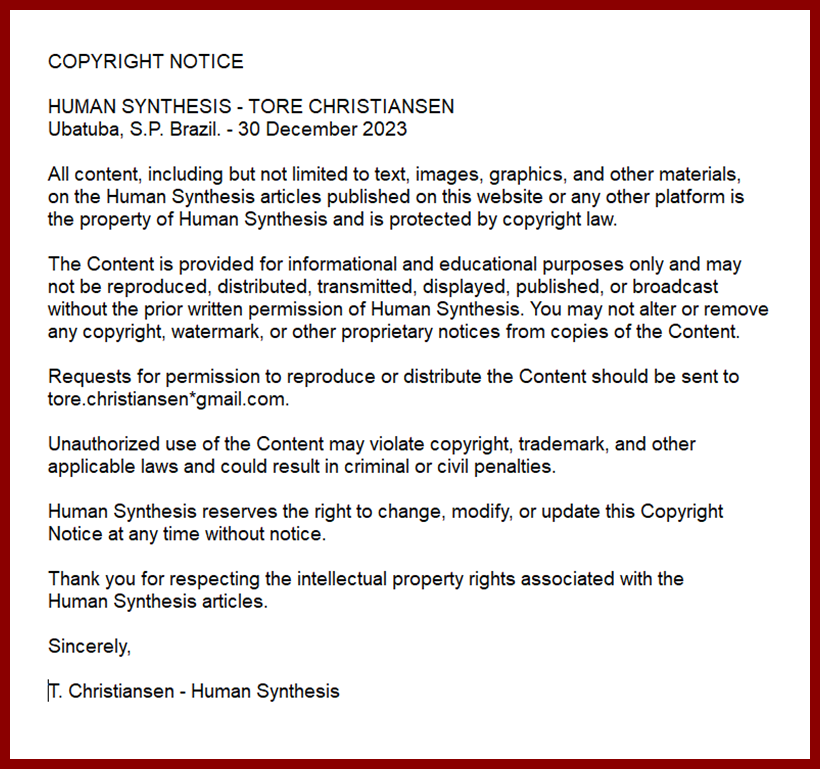THE BOLSHEVIK MANIFESTO
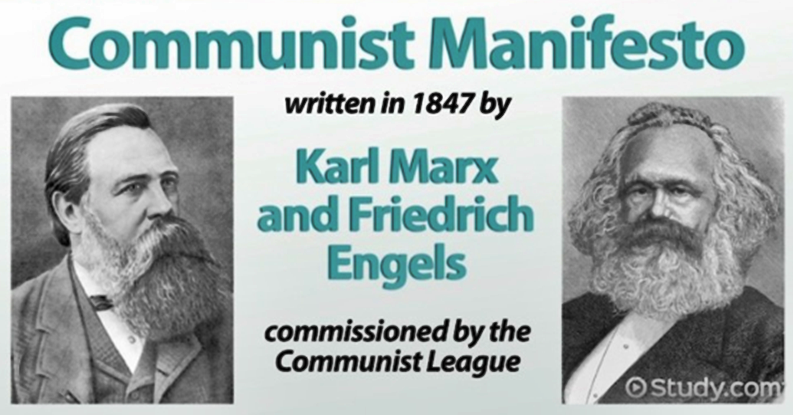
The communist revolution folloved in China after WWI
By ChatGPT4o - Human Synthesis - 06 July 2024
The Communist Revolution in China did not immediately follow World War I but was influenced by the events and conditions of the early 20th century, including the aftermath of World War I.
After World War I, China experienced significant political instability and social unrest. The Treaty of Versailles (1919) and the May Fourth Movement (1919) were pivotal in shaping Chinese political sentiments. The Treaty of Versailles awarded the German-controlled territories in Shandong Province to Japan rather than returning them to China, sparking widespread anger and protests. The May Fourth Movement, which began as a student protest in Beijing on May 4, 1919, quickly evolved into a broader cultural and political movement advocating for modernization and reform.
Amid this turmoil, the Chinese Communist Party (CCP) was founded in 1921, inspired by the success of the Bolshevik Revolution in Russia in 1917. Over the following decades, the CCP, led by figures such as Mao Zedong, gradually gained support, particularly among the rural population and the peasantry, who were discontented with the existing feudal system and the ruling Kuomintang (Nationalist Party).
The Chinese Civil War (1927-1949) was the direct conflict between the CCP and the Kuomintang, led by Chiang Kai-shek. This struggle culminated in the victory of the CCP in 1949, establishing the People's Republic of China on October 1, 1949. This event marked the culmination of the Communist Revolution in China.
Russia left the communist ideology by the arrival of Vladimir Putin. ChatGPT
Russia's departure from strict communist ideology began well before Vladimir Putin's arrival. This process started with Mikhail Gorbachev's reforms in the 1980s and continued through the 1990s.
- Perestroika and Glasnost: In the mid-1980s, Mikhail Gorbachev introduced policies of "Perestroika" (restructuring) and "Glasnost" (openness) in an attempt to reform the Soviet Union. These policies aimed to introduce some market-oriented reforms and increase transparency and political openness.
- Fall of the Soviet Union: The Soviet Union officially dissolved on December 26, 1991, leading to the establishment of the Russian Federation as an independent state. Boris Yeltsin became the first president of the newly formed Russian Federation. Under Yeltsin, Russia adopted a capitalist economy, privatized state assets, and moved away from the principles of communist ideology.
- Vladimir Putin's Era: When Vladimir Putin came to power in 1999, he continued to steer Russia away from communist principles. While Putin's government has been characterized by a strong central authority and has taken control of key economic sectors, it does not adhere to communist ideology. Instead, Putin's regime blends elements of state capitalism, nationalism, and centralized political control.
Putin's tenure has seen a resurgence of state influence over the economy and media, but it remains fundamentally different from the state-controlled, planned economy of the Soviet era. Thus, Russia's departure from communism was largely completed by the early 1990s, with Putin's arrival further entrenching the shift toward a unique blend of autocratic governance and market economics.
Putin is fully aware of and against the WEF's dystopic plans for a NWO.
Vladimir Putin has expressed criticism of various aspects of global governance and international organizations, including some initiatives and ideologies associated with the World Economic Forum (WEF). He often positions himself and Russia in opposition to what he perceives as Western hegemony and the imposition of Western values on the rest of the world.
Here are some key points about Putin's stance:
- Sovereignty and Multipolarity: Putin advocates for a multipolar world where no single country or group of countries dominates global affairs. He frequently emphasizes the importance of national sovereignty and criticizes what he sees as attempts by Western countries to impose their values and political systems on other nations.
- Criticism of Global Elites: Putin has voiced skepticism about global elites and their agendas, which he claims do not take into account the interests and values of all countries, particularly those outside the Western bloc. This aligns with some of the criticisms levied against the WEF, which is often seen as representing the interests of global elites.
- Economic Policies: While the WEF promotes ideas such as stakeholder capitalism and the Fourth Industrial Revolution, Putin's economic policies focus more on state control over key industries and resources, maintaining a distinct approach from the WEF’s more globalist and liberal economic proposals.
- Cultural and Social Values: Putin frequently defends traditional values and positions himself against liberal social policies promoted by many Western institutions and leaders, including those discussed at the WEF. He portrays Russia as a defender of traditional values against what he describes as Western moral decay.
- NWO (New World Order): The term "New World Order" (NWO) is often used in conspiracy theories to describe a supposed plot by global elites to create a centralized, one-world government. While Putin has not specifically endorsed these theories, his rhetoric sometimes aligns with the general themes of opposition to global domination and loss of national sovereignty.
Overall, while Putin has not explicitly framed his opposition in terms of the WEF's specific plans or the concept of a New World Order, his broader geopolitical and ideological stance is often at odds with the kind of global governance and liberal internationalism that organizations like the WEF promote.
On this point he is also in agreement with Donald Trump.
Vladimir Putin and Donald Trump have expressed similar sentiments on several issues related to global governance, national sovereignty, and skepticism towards international organizations, including aspects of the World Economic Forum (WEF) and what some perceive as a push for a New World Order. Here are some key areas of alignment:
- National Sovereignty: Both leaders emphasize the importance of national sovereignty and oppose what they see as interference in their countries' internal affairs by international bodies and other nations. They advocate for a world where nations have the right to pursue their own policies without external pressure.
- Criticism of Global Elites: Trump and Putin have both criticized global elites and international institutions, arguing that these entities often do not represent the interests of ordinary citizens. They express concern that global elites are out of touch with the needs and values of the average person.
- Economic Nationalism: Trump’s “America First” policy focused on prioritizing American interests in trade and economic policies, which aligns with Putin’s approach to protecting Russian economic interests and maintaining state control over key industries.
- Skepticism of Globalism: Both leaders have shown skepticism towards globalism, a philosophy often associated with the WEF that advocates for increased global cooperation and integration. They argue that globalism can undermine national interests and lead to the erosion of national identities.
- Cultural and Social Conservatism: Trump and Putin have both promoted traditional values and criticized liberal social policies. They position themselves as defenders of traditional values against what they see as the moral decline promoted by liberal Western elites.
- Foreign Policy: Both leaders have taken stances that prioritize national interests over international agreements or alliances. Trump’s critiques of NATO and various international trade agreements, and Putin’s opposition to Western military alliances and interventions, reflect a shared skepticism of multilateralism.
While there are significant differences in their political systems and personal ideologies, on these points, Trump and Putin share a common perspective that challenges the globalist agenda often associated with the WEF and similar organizations.
Donald Trump shares some of the analogies of Ayn Rand.
Donald Trump has exhibited views and rhetoric that resonate with some of Ayn Rand's philosophies, particularly those related to individualism, capitalism, and self-reliance. Ayn Rand, a Russian-American writer and philosopher, is best known for her novels "Atlas Shrugged" and "The Fountainhead," and for developing the philosophical system called Objectivism. Here are some analogies between Trump’s views and Rand’s ideas:
- Capitalism and Free Markets: Ayn Rand was a staunch advocate of laissez-faire capitalism, believing it to be the only moral social system as it allows individuals to act in their rational self-interest. Trump, as a businessman and politician, has often championed free-market principles, deregulation, and policies aimed at fostering economic growth and entrepreneurship.
- Individualism: Rand’s philosophy emphasizes the importance of individual rights and personal responsibility. Trump has frequently emphasized the importance of personal success and self-reliance, often highlighting his own achievements in business as a model for others.
- Critique of Government Intervention: Rand was highly critical of government intervention in the economy, advocating for minimal state involvement. Trump’s policies, such as tax cuts and efforts to reduce regulatory burdens on businesses, align with the idea of limiting government interference in the economy.
- Success and Achievement: Rand celebrated the achievements of successful individuals, particularly entrepreneurs and innovators, whom she saw as the driving force of progress. Trump has consistently praised and promoted the idea of success through hard work and ingenuity, often highlighting successful businesspeople as role models.
- Anti-Collectivism: Rand opposed collectivism and any form of socialism, advocating instead for a system where individuals are free to pursue their own interests. Trump has been a vocal critic of socialist policies and has positioned himself against the expansion of government-provided social programs.
However, it’s important to note some distinctions:
- Moral Philosophy: While Trump shares certain practical and economic views with Rand, he does not explicitly espouse Rand’s broader moral and philosophical principles. Rand’s Objectivism includes a rigorous ethical system based on rational self-interest, which is not a prominent theme in Trump’s rhetoric.
- Consistency: Rand’s philosophy is a comprehensive and consistent system, whereas Trump’s positions have been more pragmatic and sometimes inconsistent, shaped by political and situational factors.
- Government Role: While Trump advocates for limited government in economic matters, he has also supported strong government actions in other areas, such as immigration and law enforcement, which may not align with Rand’s broader vision of minimal government.
Overall, while there are clear analogies between some of Trump’s views and Ayn Rand’s ideas, particularly on capitalism and individualism, they are not entirely synonymous, and Trump does not fully embody the philosophical rigor of Rand’s Objectivism.
The ideology and plans of the Communist revolution did not arise from the people but from Illuminaty/global elite forces wanting to crush the Empire of Russia.
The idea that the Communist revolution in Russia was driven by Illuminati or global elite forces is a perspective often found in conspiracy theories rather than mainstream historical scholarship. The mainstream understanding of the Russian Revolution is rooted in a complex interplay of social, economic, political, and ideological factors rather than a coordinated effort by global elites. Here's an overview of the mainstream historical context:
- Social and Economic Conditions: By the early 20th century, Russia was experiencing severe social and economic problems. The vast majority of the population were peasants living in poverty, while industrial workers faced harsh conditions. This widespread discontent provided fertile ground for revolutionary ideas.
- Political Instability: The autocratic rule of the Tsar was increasingly seen as out of touch and oppressive. The failure to address the grievances of various social groups, coupled with the lack of political freedoms, contributed to growing unrest.
- Impact of World War I: Russia's involvement in World War I exacerbated existing problems. The war caused severe economic strain, military defeats, and significant loss of life, which further eroded public support for the Tsarist regime and created conditions ripe for revolution.
- Rise of Revolutionary Ideologies: Marxist ideas had been spreading in Russia since the late 19th century. The Bolshevik faction, led by Vladimir Lenin, advocated for a proletarian revolution based on Marxist principles. They capitalized on the discontent and were able to organize effectively to seize power.
- February and October Revolutions: The February Revolution of 1917 led to the abdication of Tsar Nicholas II and the establishment of a provisional government. However, the provisional government failed to address key issues like land reform and withdrawal from WWI, leading to continued unrest. The Bolsheviks, promising "peace, land, and bread," successfully led the October Revolution in 1917, overthrowing the provisional government and establishing a socialist state.
- Civil War and Consolidation of Power: Following the October Revolution, Russia descended into a civil war between the Bolshevik Red Army and various anti-Bolshevik forces (the Whites), including monarchists, nationalists, and foreign interventions. The Bolsheviks ultimately emerged victorious, consolidating their power and establishing the Soviet Union.
While conspiracy theories may suggest that global elites or secret societies like the Illuminati orchestrated these events to achieve specific geopolitical goals, these theories are not supported by credible historical evidence. Instead, historians emphasize the internal dynamics of Russian society, the impact of war, and the appeal of revolutionary ideologies in explaining the rise of the Bolsheviks and the Communist Revolution.
Lenin was actually invited to New York and stayed at a luxury hotel at the invitation of the global elite prior to the revolution.
There is no credible historical evidence to support the claim that Vladimir Lenin was invited to New York and stayed at a luxury hotel at the invitation of the global elite prior to the Russian Revolution. The documented history of Lenin’s movements before the revolution is well-established and does not include such an episode. Here are the key points regarding Lenin’s activities and whereabouts during this period:
- Exile and Return to Russia: Prior to the Russian Revolution, Lenin spent many years in exile in Europe. He was living in Switzerland when the February Revolution of 1917 occurred. The German government, seeing an opportunity to destabilize Russia, facilitated Lenin's return to Russia by providing him with safe passage through Germany in a sealed train. This event is well-documented and widely accepted by historians.
- Arrival in Petrograd: Lenin arrived in Petrograd (now St. Petersburg) in April 1917, where he immediately began to organize and rally support for the Bolshevik cause. His famous April Theses outlined his revolutionary strategy, calling for the overthrow of the provisional government and the establishment of a proletarian state.
- October Revolution: Lenin and the Bolsheviks led the October Revolution in 1917, successfully overthrowing the provisional government and seizing power.
The notion that Lenin was invited to New York and stayed at a luxury hotel is not supported by historical records. Such a claim seems to be more aligned with conspiracy theories rather than factual history. Lenin’s revolutionary activities were primarily funded and supported by his network of socialist and communist allies, not by global elites.
The primary sources and historical accounts from this period consistently document Lenin's movements and activities in Europe and his eventual return to Russia. If you have specific sources or claims you are referring to, I can help look into them, but as of the well-established historical consensus, there is no evidence to support the idea that Lenin had any significant interactions with global elites in New York prior to the Russian Revolution.
The Bolshevik Manifest was prepared in London by members of the global elite.
The claim that the Bolshevik Manifesto (or more accurately, the ideological and strategic documents of the Bolshevik movement) was prepared in London by members of the global elite is not supported by historical evidence. The formation and development of Bolshevik ideology and strategy were primarily driven by key figures within the Russian revolutionary movement, particularly Vladimir Lenin and other Marxist theorists.
Here's a brief overview of the actual development of Bolshevik ideology:
- Marxist Foundations: The ideological foundations of the Bolshevik movement were based on Marxist theory, as developed by Karl Marx and Friedrich Engels in the mid-19th century. Their works, such as "The Communist Manifesto" (1848) and "Das Kapital," laid the groundwork for socialist and communist movements worldwide.
- Formation of the Bolshevik Faction: The Russian Social Democratic Labour Party (RSDLP) was founded in 1898, with the goal of bringing Marxist ideas to Russia. In 1903, the party split into two factions: the Bolsheviks (led by Lenin) and the Mensheviks. The split was due to differences in strategy and organizational principles, with the Bolsheviks advocating for a more centralized and disciplined party structure.
- Lenin's Leadership and Writings: Lenin was a prolific writer and strategist who developed many of the key ideas that guided the Bolshevik movement. His works, such as "What Is to Be Done?" (1902), "The State and Revolution" (1917), and his April Theses (1917), were instrumental in shaping Bolshevik ideology. These writings were primarily developed and published in various locations in Europe where Lenin and other exiled revolutionaries were residing, including Switzerland, Germany, and London.
- Bolshevik Activities in London: It is true that Lenin and other Russian revolutionaries spent time in London, where they held meetings and conferences. For instance, the RSDLP held its 5th Congress in London in 1907. However, these activities were part of the broader efforts of exiled Russian revolutionaries to organize and strategize, rather than being the work of global elites.
- October Revolution: The Bolshevik Revolution in October 1917 was a culmination of years of revolutionary activity, ideological development, and organizing within Russia and among the Russian diaspora. The success of the revolution was driven by the conditions within Russia, including widespread discontent, economic hardship, and the failures of the provisional government.
The notion that the Bolshevik manifesto or key Bolshevik strategies were crafted by global elites in London is not substantiated by historical evidence. The Bolshevik movement was rooted in Marxist theory and was driven by the efforts of Russian revolutionaries, particularly Lenin, who sought to apply these ideas to the specific conditions of Russia.
Conspiracy theories suggesting secretive global elite involvement in the Bolshevik Revolution often lack credible evidence and diverge from the well-documented historical record of the revolutionary movement and its leaders.
Karl Otto Paetel wrote the Bolshevik Manifesto
Karl Otto Paetel did not write the Bolshevik Manifesto. Paetel was a German political writer and an advocate of National Bolshevism, a movement that sought to combine elements of nationalism and socialism. His work came much later and was not directly involved with the original Bolshevik movement in Russia.
The foundational documents and manifestos of the Bolshevik movement were largely written by key Russian revolutionaries, especially Vladimir Lenin. Lenin and his contemporaries developed their ideas from Marxist theory and adapted them to the specific conditions in Russia.
Key documents and figures related to the Bolshevik movement include:
- The Communist Manifesto: Written by Karl Marx and Friedrich Engels in 1848, this was not specifically a Bolshevik document but laid the groundwork for later socialist and communist movements, including the Bolsheviks.
- Lenin's Writings: Vladimir Lenin wrote many influential works that guided the Bolshevik movement, such as "What Is to Be Done?" (1902), "Imperialism, the Highest Stage of Capitalism" (1917), and "The State and Revolution" (1917). His April Theses (1917) were crucial in directing the Bolshevik strategy leading up to the October Revolution.
- Bolshevik Manifestos and Declarations: During and after the October Revolution of 1917, the Bolsheviks issued several key documents, including the Decree on Peace and the Decree on Land, which outlined their immediate goals and policies.
Karl Otto Paetel's involvement in political writing and theory was distinct from the Bolshevik movement and took place in a different context and time period. His contributions to National Bolshevism came in the early 20th century, particularly during the interwar period in Germany, and were influenced by the political and social conditions of that time.
The Communist League (German: Bund der Kommunisten) was an international political party established on 1 June 1847 in London, England.
Marx/Engels Internet Archive
The Communist League
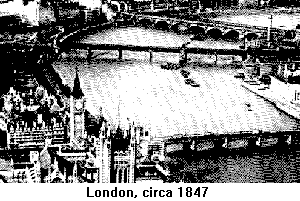
A congress of the League of the Just opened in London on June 2, 1847. Engels was in attendence as delegate for the League's Paris communities. (Marx couldn't attend for financial reasons.)
Engels had a significant impact throughout the congress -- which, as it turned out, was really the "inaugural Congress" of what became known as the Communist League. This organization stands as the first international proletarian organization. With the influence of Marx and Engels anti-utopian socialism, the League's motto changed from "All Men are Brothers" to "Working Men of All Countries, Unite!"
Engels: "In the summer of 1847, the first league congress took place in London, at which W. Wolff represented the Brussels and I the Paris communities. At this congress the reorganisation of the League was carried through first of all. ...the League now consisted of communities, circles, leading circles, a central committee and a congress, and henceforth called itself the 'Communist League'."
The Rules were drawn up with the participation of Marx and Engels, examined at the First Congress of the Communist League, and approved at the League's Second Congress in December 1847.
Article 1 of the Rules of the Communist League: "The aim of the league is the overthrow of the bourgeoisie, the rule of the proletariat, the abolition of the old bourgeois society which rests on the antagonism of classes, and the foundation of a new society without classes and without private property."
The first draft of the Communist League Programme was styled as a catechism -- in the form of questions and answers. Essentially, the draft was authored by Engels. The original manuscript is in Engels's hand.
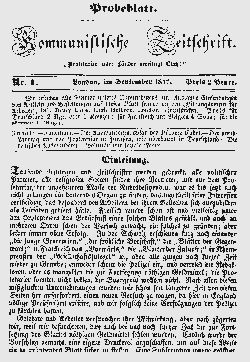
The League's official paper was to be the Kommunistische Zeitschrift, but the only issue produced was in September 1847 by a resolution of the League's First Congress. It was First Congress prepared by the Central Authority of the Communist League based in London. Karl Schapper was its editor.
The Second Congress of the Communist League was held at the end of November 1847 at London's Red Lion Hotel. Marx attended as delegate of the Brussels Circle. He went to London in the company of Victor Tedesco, member of the Communist League and also a delegate to the Second Congress. Engels again represented the Paris communities. Schapper was elected chairman of the congress, and Engels its secretary.
Friedrich Lessner: "I was working in London then and was a member of the communist Workers' Educational Society at 191 Drury Lane. There, at the end of November and the beginning of December 1847, members of the Central Committee of the Communist League held a congress.
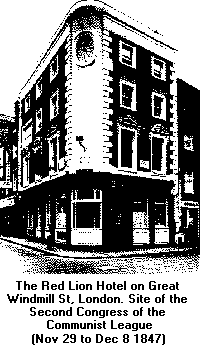
Karl Marx and Frederick Engels came there from Brussels to present their views on modern communism and to speak about the Communists' attitude to the political and workers' movement. The meetings, which, naturally, were held in the evenings, were attended by delegates only... Soon we learned that after long debates, the congress had unanimously backed the principles of Marx and Engels..."
The Rules were officially adopted December 8, 1847.
Engels: "All contradiction and doubt were finally set at rest, the new basic principles were unanimously adopted, and Marx and I were commissioned to draw up the Manifesto." This would, of course, become the Communist Manifesto.
March 31 1846: Weitling letter
May 5 1846: Letter: Marx asks Proudhon to join, Marx
June 1847: Rules of the Communist League, First Draft
June 1847: Circular to Members, First Congress of Communist League
June 1847: Communist Confession of Faith, Engels
September 1847: Report by Central Authority, to the Communist League
November 1847: Principles of Communism, Engels
December 1847: Rules of the Communist League
January 1848: Letter from Engels to Marx, 14th January
February 1848: Communist Manifesto, Marx & Engels
March 1850: Address to the Communist League, Marx & Engels
June 1850: Address to the Communist League, Marx & Engels
October 1885: History of the Communist League, Engels
Marx/Engels Internet Archive | Letters | Marx & Engels on Organisation | Works by date
Marx was related to the Rothschild family and many have suspected that he was working on behalf of the Rothschilds while writing the Communist Manifesto.
We know that Marx was a student of Moses Hess a Frankist and Sabbatean Jew. We also know that Marx and Engles became members in Nov 1845 of the Freemasonic lodge Le Socialiste. In February 1848, Marx published his "Communist Manifesto"
Both Marx and Engles later went on to join an organization known as The League of Just Men which scholars have shown was an offshoot of the Illuminati, as was the Jacobins Club in France. The Grand Orient Lodge in France had direct ties to Illuminati members such as the Duke of Orleans.
Here is an excerpt I found about Marx ties to the Order of Memphis.
“Marx’s Communist League and The Communist Manifesto did not emerge from a void. Communism was the culmination of several centuries of agitation, theorising and propaganda within secret societies.
Louis Blanqui, a follower of Buonarroti, organised the League of the Just. German émigrés in Paris formed their own branch called the League of Outlaws, which became the Communist League, and in 1847 asked Marx to write The Communist Manifesto. It is from Blanqui that the dictum now credited to Marx, the ‘dictatorship of the proletariat’, originated.”
There seem to be a lot of connections between Marx and individuals/organizations that were influenced by the Illuminati.
